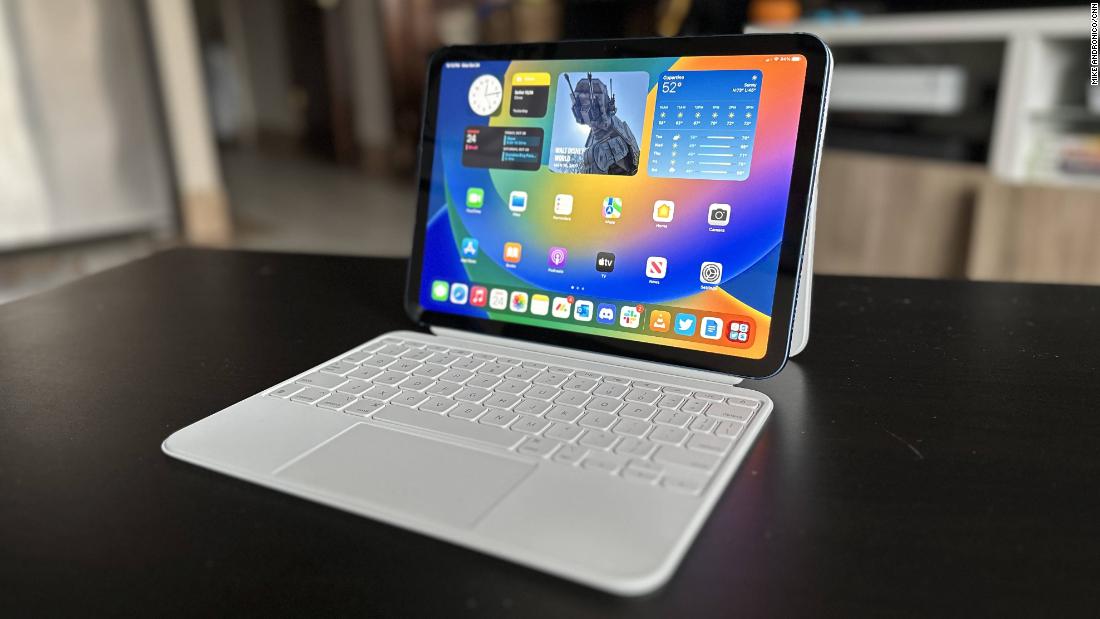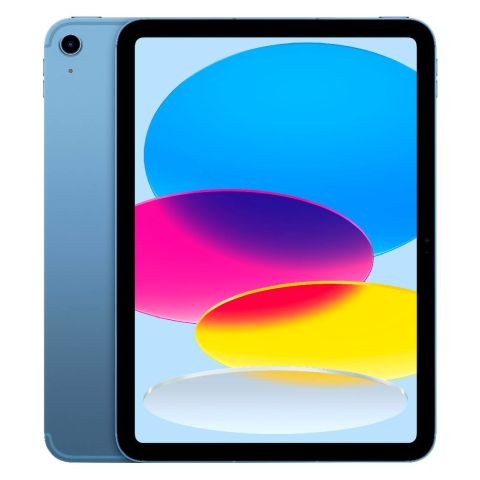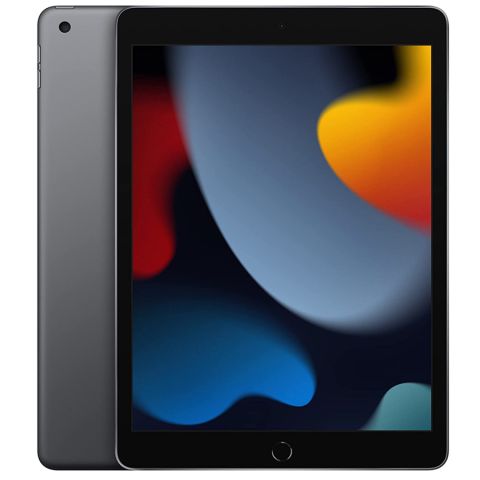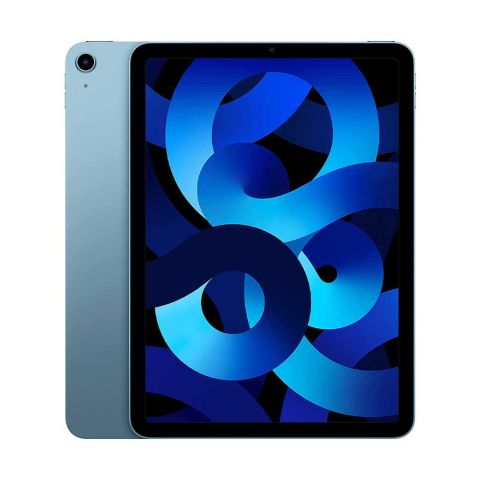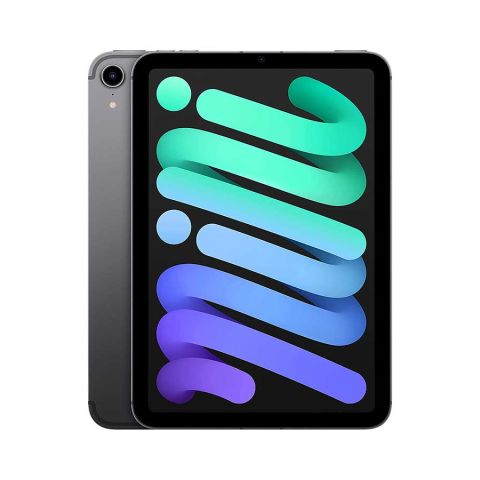The 10th-generation iPad is both excitingly new and confusingly familiar all at once. On one hand, it’s a big leap forward from the ninth-gen model, offering a completely revamped design (yay, colors!) alongside modern niceties like USB-C, 5G support and a bigger, more immersive screen. On the other hand, it’s now oddly similar to the latest iPad Air and iPad Mini models, both of which are arguably a better value when you stack them head-to-head.
There’s no denying that the new iPad is a great tablet, with fast performance, a vivid display and all of the software magic that makes any Apple slate a joy to use. But is it the right iPad for you? Here’s what I think after many long days of playing games, chatting with friends and writing this very review on it.
A great iPad, but you could do better
The 10th-gen iPad is a great tablet for first-time iPad buyers or those who haven’t upgraded in years. However, most folks are better off saving money on the ninth-gen model, or spending a bit more for the faster, more advanced iPad Air.

The base iPad’s dull gray exterior and chunky bezels are officially a thing of the past. The 10th-gen iPad finally brings Apple’s flagship tablet to the modern era, adopting the same sleeker edges and thinner display borders as the latest iPad Mini, Air and Pro models while also introducing a range of fun color options.
The blue review unit I’ve been testing is stunning, and a refreshing change from the usual gray and silver options found on older iPad models. You can also pick the slate up in red, yellow or silver. Fortunately, Apple’s latest tablet feels as great as it looks, with an airy 1-pound design that was comfortable to hold throughout long sessions of couch-bound gaming and web surfing. The Touch ID button now rests at the top of the display rather than the front to allow for those slimmer display bezels, and it was reliable as ever for unlocking the iPad with a quick fingerprint scan.
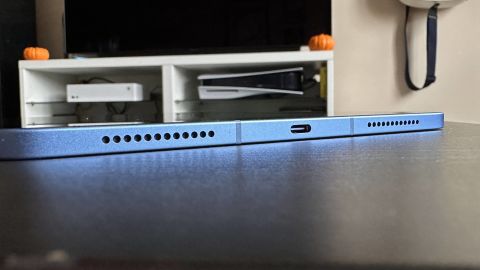
Perhaps even more significant than the new iPad’s overhauled design and shiny color options is the long-awaited switch from Lightning to USB-C for charging. This gives the iPad the same charging port as just about every modern tech gadget (including Apple’s own MacBooks and higher-end iPads), and allows it to be instantly compatible with the wealth of USB-C cables and accessories you might already have lying around the house.
As someone with a litany of such cables in every room of my apartment, I loved being able to charge the iPad with whatever I had handy rather than hunt down my scarcer collection of Lighting cables. The transition from Lightning to USB-C may introduce some compatibility headaches for those upgrading from an older iPad (more on that later), but ultimately, it’s great to see Apple’s most popular iPad finally adopt the industry standard.
Great performance and the power of iPadOS
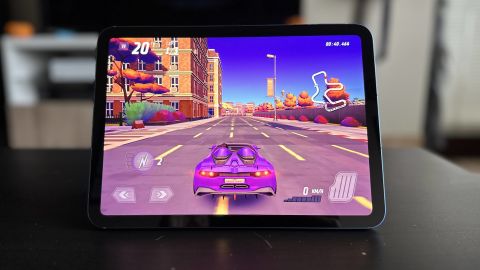
The iPad has long offered the best tablet performance you can get for the money, and that remains the case with the 10th-gen model. Apple’s latest tablet zipped through every task I threw at it — flipping through the home screen and switching between apps felt smooth and instantaneous, and console-quality games like NBA 2K23 ran without a hitch.
The new iPad’s brisk performance can be credited to its A14 Bionic chip — the same processor that powers 2020’s iPhone 12 range, and one that delivers a small but still notable bump over the A13 Bionic in the previous iPad. On Geekbench 5 (a general processing benchmark), the latest iPad delivered multi-core scores that were more than double that of the ninth-gen model, roughly on par with the latest iPad Mini and notably higher than the much more expensive Galaxy Tab S8 Ultra. The new iPads scores weren’t quite on the same astronomical levels as the new, pricier iPad Pro models (which are powered by Apple’s laptop-grade M2 chips), but they’re the best we’ve seen on a tablet at this price.
You likely won’t notice a big difference between the 10th- and ninth-gen iPad in day-to-day use, but the added muscle makes the newer model more future-proof — and a much better value than the competition in terms of sheer speed. In fact, with a Magic Keyboard Folio attached, the new iPad was mostly able to replace my laptop for everyday work tasks.
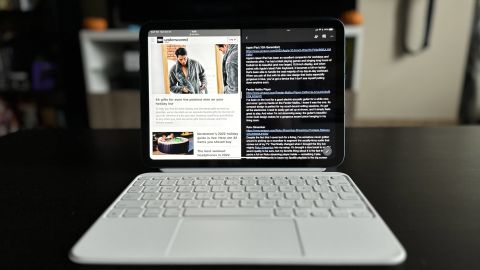
Thanks to that zippy A14 chip and the powers of iPadOS 16, I was able to smoothly multitask between apps like Slack and Outlook in split-screen mode without a hint of slowdown. I found the iPad to be a better laptop replacement than the Galaxy Tab S8 Ultra, mostly because iPadOS apps seem better optimized for a keyboard and trackpad than their Android counterparts. I still ran into a few snags (the Google Docs app was particularly cumbersome, go figure), and many of iPadOS 16’s key productivity features — like the Stage Manager multitasking mode and external display support — are limited to Apple Silicon-powered iPads, such as the latest iPad Air and Pro. That being said, I was still impressed by what I was able to get done on a $449 tablet.
The new iPad’s battery life is likewise dependable, getting me through most of an intensive eight-hour workday as well as a full lazy Sunday that involved lots of graphically rich gaming and hours of streaming live football (thankfully, the Jets won). Video playback was definitely the biggest drain — the tablet gave out after just over five hours on our continuous 4K video test — but in terms of everyday on-and-off use, you likely won’t have to charge the iPad more than once a day.
A vibrant, large display and improved cameras
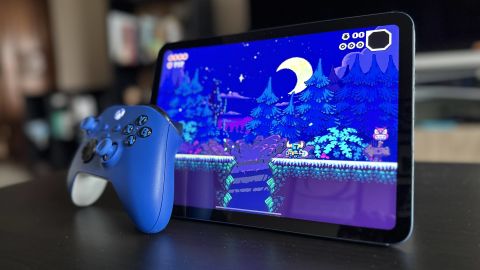
The new iPad’s slimmer bezels don’t just look nicer; they also allow for a bump in overall screen space — 10.9 inches over 10.2 inches, to be exact. It’s not huge, but it allows for even more real estate on what’s long been a vibrant canvas. Everything from the colorful cars of Horizon Chase 2 to the nostalgic pixelated graphics of Shovel Knight Dig popped beautifully off the screen, and when I fired up the trailer for Ant-Man: Quantumania, the film’s otherworldly sci-fi realms were packed with intricate detail.
That said, the base iPad display is starting to show its age, particularly if you’re used to the smoother, richer screens on the iPad Pro series. Certain details (such as the text under app icons) look just a tad pixelated, and after getting used to the fluid 120Hz ProMotion display on my iPhone 14 Pro, the iPad’s standard 60Hz screen feels a little bit sluggish when scrolling through apps and webpages.
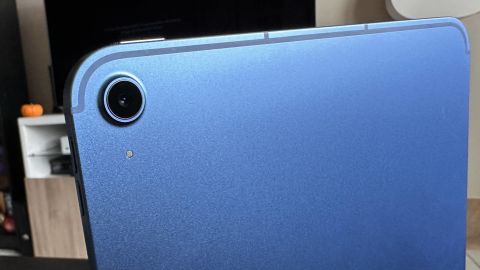
The 10th-gen iPad delivers some slight improvements on the camera front, starting with a 12-megapixel TrueDepth front camera that’s now optimized for landscape orientation — something that helped me stay perfectly centered during FaceTime calls with friends and family. And any time I moved, Apple’s Center Stage technology (which follows your face to keep you in focus) was there to get me right back in frame. Center Stage isn’t new (you’ll also find it on the previous-gen iPad), but it’s still a trip to see in action, and worked reliably across calls on FaceTime and Webex.
If you’re one of those people who feel comfortable taking photos and videos with a tablet in public, you’ll be happy to know that the rear-facing camera has been upgraded to 12 megapixels (up from 8) and can now shoot 4K video. The shots I captured of my dog and various household objects on this camera were good enough but not nearly as detailed as what I get from my iPhone 14 Pro. It’ll work fine in a pinch — just don’t expect this iPad to replace your phone camera anytime soon.
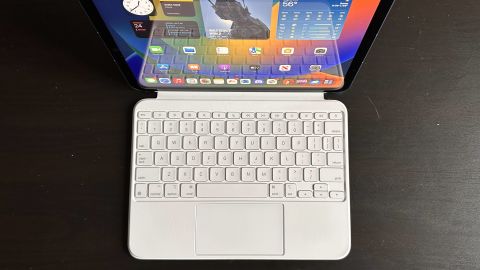
I’ve been using the iPad in tandem with Apple’s new $249 Magic Keyboard Folio, which just might be the company’s best keyboard cover yet. Its bouncy, satisfying keys feel nearly as good as the ones on my MacBook, and its trackpad gives me ample space for navigating apps and browser tabs. And unlike Apple’s other iPad keyboards — including the $299 Magic Keyboard for the iPad Pro — it has a full row of physical function keys for doing things like adjusting brightness, volume or audio playback with a quick tap. It makes for the most satisfying laptop experience on any iPad, at least in terms of using a keyboard.
The Magic Keyboard Folio’s rear cover is just as reliable, with an adjustable kickstand that easily props up the iPad at multiple viewing angles. The whole setup provides a solid layer of rubberized protection when it’s folded up, and I especially love the two-tone look the white Folio makes with my blue iPad. I just wish this helpful accessory didn’t cost a whopping $249 — especially considering that the Smart Keyboard won’t carry over from older iPad models due to incompatible sizes. It’s also frustrating that the Magic Keyboard Folio is currently exclusive to the 10th-gen iPad, meaning owners of every other model are locked out of what we consider to be the best keyboard option.
That said, you can always connect a Bluetooth keyboard or go with a cheaper third-party option like the excellent Logitech Combo Touch. But if you do splurge on the new Folio, you’ll find a lot to like.
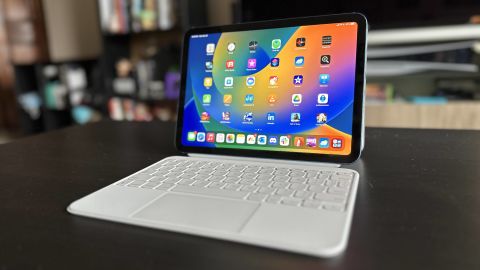
The 10th-gen iPad’s many upgrades come at the expense of its $449 price tag, which is a pretty significant bump over the $329 (and often discounted) ninth-gen model. It’s not a completely ridiculous asking price when you compare the two on paper, but when you put it up against the iPad lineup as a whole, it becomes hard to figure out who this new model is aimed at.
The latest iPad is oddly similar on paper to the fifth-gen iPad Air ($599), which gets you a faster M1 processor, second-gen Apple Pencil support and a marginally thinner design for your extra money. That’s a pretty big price gap, but if you’re able to score an Air at a discount (like you can on Amazon right now for $519), you’re essentially getting the same tablet with a much better processor for serious productivity.
For just $50 more than the 10th-gen iPad, you can get the sixth-gen iPad Mini, which features a slightly faster A15 processor and a more compact 8.3-inch design alongside second-gen Apple Pencil support. It’s the better option for portability, but it also sacrifices first-party keyboard support.
And then there’s the still-excellent ninth-gen model. For $329 or less (it’s currently $299 on Amazon), you’re getting the same core software experience, the same Apple Pencil support (with no dongle required) and very similar performance. The real perks of paying up for the $449 iPad are the bigger screen, nicer design and 5G support. Those are nothing to sneeze at, but for the vast majority of people who just want a great tablet for streaming, sketching, gaming and some light productivity, the ninth-gen iPad is still the better value.
Apple Pencil awkwardness and a short cable
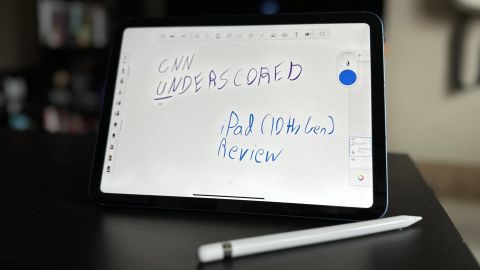
The new iPad continues to support the first-generation Apple Pencil, and it worked great for everything from writing quick to-do lists or applying various levels of pressure while doodling in Sketchbook. But because of the iPad’s switch to USB-C, the already awkward process of pairing and charging your Apple Pencil has gotten even more complicated.
The Apple Pencil has a Lightning connector directly on its top end, which previously meant that you plugged the pen directly into your iPad’s Lightning port to pair and charge it. It’s an odd solution, but at least it’s plug-and-play. On the 10th-gen model, you have to attach said Lightning connector to a USB-C to Apple Pencil adapter, which then connects to your iPad via a USB-C cable. The result? This hilarity in the image below.
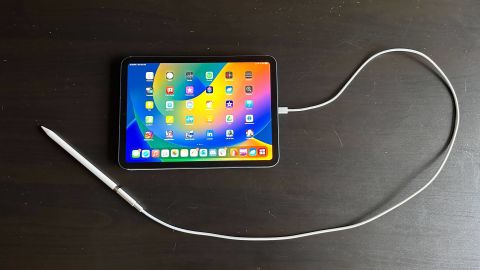
I’m perfectly accustomed to using adapters in my daily life, but the sheer amount of pieces you have to put together just to connect an Apple Pencil to the new iPad is ridiculous. The USB-C to Apple Pencil adapter is also tiny, and is the kind of accessory that’s easy to misplace if you’re clumsy like me. This adapter now comes standard with any new first-gen Apple Pencils, though folks who already own the pencil will have to pay an extra $9.
It’s also disappointing that this iPad still won’t support the more advanced second-gen Apple Pencil, which offers such perks as wireless charging/pairing and double-tap controls for changing tools. Considering that this advanced Apple Pencil works with the similar iPad Air and iPad Mini, it makes little sense that the 10th-gen iPad was left out.
Finally, it’s a good thing that the iPad works with any USB-C cable (just make sure you have a good charging brick), because the one you get out of the box is too short. I often use the iPad at my desk as a laptop replacement, and the included 3-foot braided cable isn’t nearly long enough to reach from my power strip to the tablet’s charging port. To fix the situation, I’ve been relying on the much longer USB-C cord that I use to charge my MacBook Pro when I’m in work mode.
| Display |
10.9-inch, 2360 x 1640 Liquid Retina display |
10.2-inch, 2160 x 1620 Retina display |
10.9-inch, 2360 x 1640 Liquid Retina display |
8.3-inch, 2266 x 1466 Liquid Retina display |
|---|---|---|---|---|
| Processor |
A14 Bionic |
A13 Bionic |
Apple M1 |
A15 Bionic |
| Cameras |
12-megapixel landscape ultrawide camera (front); 12-megapixel wide camera with 4K video (rear) |
12-megapixel ultrawide camera (front); 8-megapixel rear camera |
12-megapixel ultrawide camera (front); 12-megapixel wide camera with 4K video (rear) |
12-megapixel ultrawide camera (front); 12-megapixel wide camera with 4K video (rear) |
| Apple Pencil support |
1st generation (adapter required) |
1st generation |
2nd generation |
2nd generation |
| Keyboard support |
Magic Keyboard Folio |
Smart Keyboard |
Magic Keyboard, Smart Keyboard Folio |
Bluetooth only |
| Connectivity |
Wi-Fi 6, 5G, USB-C |
Wi-Fi, 4G, Lightning |
Wi-Fi 6, 5G, USB-C |
Wi-Fi 6, 5G, USB-C |
| Dimensions |
9.79 x 7.7 x 0.28 inches, 1.05 pounds |
9.8 x 6.8 x 0.29 inches, 1.07 pounds |
9.74 x 7.02 x 0.24 inches, 1.02 pounds |
7.69 x 5.3 x 0.25 inches, 0.65 pounds |
| Colors |
Silver, Pink, Blue, Yellow |
Space Gray, Silver |
Space Gray, Starlight, Pink, Purple, Blue |
Space Gray, Starlight, Pink, Purple |
| Price |
$449 |
$299 |
$519 |
$459 |
In a vacuum, the new 10th-generation iPad is a superb $449 tablet. It’s gorgeous, it’s faster than anything in its price range and it delivers an unrivaled software experience — whether you’re looking to be productive or just want to have fun. If you’re getting your first iPad or upgrading from a seventh-generation model or older, it’s well worth the price tag.
But when stacked up against the rest of the iPad lineup, it’s far from the best value. The $329 (and always on-sale) ninth-generation iPad is still the best tablet for the vast majority of people, offering the same core functionality with a slightly less shiny and modern design. And if you do plan on getting serious work done, you may be better off splurging for the fifth-gen iPad Air, which has an even faster M1 processor and better Apple Pencil support for not much more than the cost of the 10th-gen iPad. That leaves the latest flagship iPad stuck somewhere in the middle, and hard to fully recommend until it sees its first big discount.

